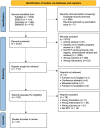Vitamin D supplementation higher than 2000 IU/day compared to lower dose on maternal-fetal outcome: Systematic review and meta-analysis
- PMID: 35796578
- PMCID: PMC9274408
- DOI: 10.1177/17455057221111066
Vitamin D supplementation higher than 2000 IU/day compared to lower dose on maternal-fetal outcome: Systematic review and meta-analysis
Abstract
Introduction: Although vitamin D is widely known as an essential micronutrient during pregnancy, the exact supplementation dose to prevent maternal-fetal outcomes remains a question. This study aims to provide a systematic review and a meta-analysis of data from randomized controlled trial on > 2000 IU/day vitamin D supplementation compared to ⩽ 2000 IU/day; and ⩽ 2000 IU/day compared to placebo, on their effects on the incidence of preeclampsia, gestational diabetes mellitus, preterm birth, and differences on birth weight.
Methods: A systematic literature search on PubMed, EBSCO-MEDLINE, EMBASE, and Cochrane Central Register of Controlled Trials databases was carried out to evaluate randomized controlled trial studies on the effects of oral vitamin D > 2000 IU/day versus ⩽ 2000 IU/day; and ⩽ 2000 IU/day versus placebo, on preeclampsia, gestational diabetes mellitus, preterm birth and birth weight. Risk ratio, mean difference, and 95% confidence interval were calculated.
Results: There were a total of 27 randomized controlled trials selected. Maternal vitamin D supplementation > 2000 IU/day had a positive effect only on gestational diabetes mellitus (seven randomized controlled trials; risk ratio = 0.70, 95% confidence interval: 0.51-0.95, I2 = 0). Vitamin D supplementation ⩽ 2000 IU/day has reduced the risk of preeclampsia (three randomized controlled trials; risk ratio = 0.29, 95% confidence interval: 0.09-0.95, I2 = 0), with no significant difference when compared to > 2000 IU/day (eight randomized controlled trials; risk ratio = 0.80, 95% confidence interval: 0.51-1.24, I2 = 31). No difference in preterm birth risk and birth weight after vitamin D supplementation. The quality of evidence varies from moderate to very low certainty. The risk of preeclampsia and gestational diabetes mellitus after high-dose versus low-dose vitamin D supplementation was the ones with moderate certainty.
Conclusion: Vitamin D supplementation > 2000 IU/day might be important to reduce the risk of gestational diabetes mellitus. Lower dose vitamin D supplementation (⩽ 2000 IU/day) seemed adequate to reduce the risk of preeclampsia, with no significant difference compared to the higher dose.
Keywords: birth weight; gestational diabetes mellitus; preeclampsia; preterm birth; vitamin D.
Conflict of interest statement
Figures






Similar articles
-
The Effects of Vitamin D Supplementation During Pregnancy on Maternal, Neonatal, and Infant Health: A Systematic Review and Meta-analysis.Nutr Rev. 2025 Mar 1;83(3):e892-e903. doi: 10.1093/nutrit/nuae065. Nutr Rev. 2025. PMID: 38950419 Free PMC article.
-
Calcium supplementation during pregnancy for preventing hypertensive disorders and related problems.Cochrane Database Syst Rev. 2018 Oct 1;10(10):CD001059. doi: 10.1002/14651858.CD001059.pub5. Cochrane Database Syst Rev. 2018. PMID: 30277579 Free PMC article.
-
Regimens of vitamin D supplementation for women during pregnancy.Cochrane Database Syst Rev. 2019 Oct 3;10(10):CD013446. doi: 10.1002/14651858.CD013446. Cochrane Database Syst Rev. 2019. PMID: 31581312 Free PMC article. Review.
-
Vitamin D supplementation during pregnancy: Updated meta-analysis on maternal outcomes.J Steroid Biochem Mol Biol. 2016 Nov;164:148-155. doi: 10.1016/j.jsbmb.2016.02.008. Epub 2016 Feb 11. J Steroid Biochem Mol Biol. 2016. PMID: 26877200 Free PMC article. Review.
-
Efficacy of vitamin D supplementation in gestational diabetes mellitus: Systematic review and meta-analysis of randomized trials.PLoS One. 2019 Mar 22;14(3):e0213006. doi: 10.1371/journal.pone.0213006. eCollection 2019. PLoS One. 2019. PMID: 30901325 Free PMC article.
Cited by
-
Priority nutrients to address malnutrition and diet-related diseases in Australia and New Zealand.Front Nutr. 2024 Mar 13;11:1370550. doi: 10.3389/fnut.2024.1370550. eCollection 2024. Front Nutr. 2024. PMID: 38544756 Free PMC article.
-
Identification of Priority Nutrients in the US: Targeting Malnutrition to Address Diet-Related Disease Across the Lifespan.Nutrients. 2025 Jun 9;17(12):1957. doi: 10.3390/nu17121957. Nutrients. 2025. PMID: 40573068 Free PMC article.
-
Targeting Neutrophil Extracellular Trap Formation: Exploring Promising Pharmacological Strategies for the Treatment of Preeclampsia.Pharmaceuticals (Basel). 2024 May 9;17(5):605. doi: 10.3390/ph17050605. Pharmaceuticals (Basel). 2024. PMID: 38794175 Free PMC article. Review.
-
Supplementing Vitamin D in Different Patient Groups to Reduce Deficiency.Nutrients. 2023 Aug 25;15(17):3725. doi: 10.3390/nu15173725. Nutrients. 2023. PMID: 37686757 Free PMC article.
-
Vitamin D supplementation for women during pregnancy.Cochrane Database Syst Rev. 2024 Jul 30;7(7):CD008873. doi: 10.1002/14651858.CD008873.pub5. Cochrane Database Syst Rev. 2024. PMID: 39077939 Free PMC article.
References
Publication types
MeSH terms
Substances
LinkOut - more resources
Full Text Sources

